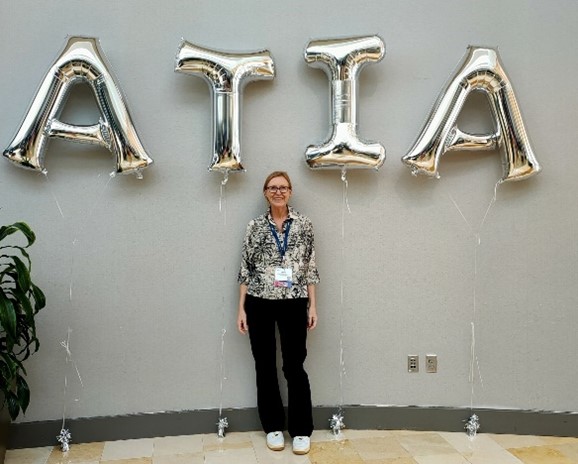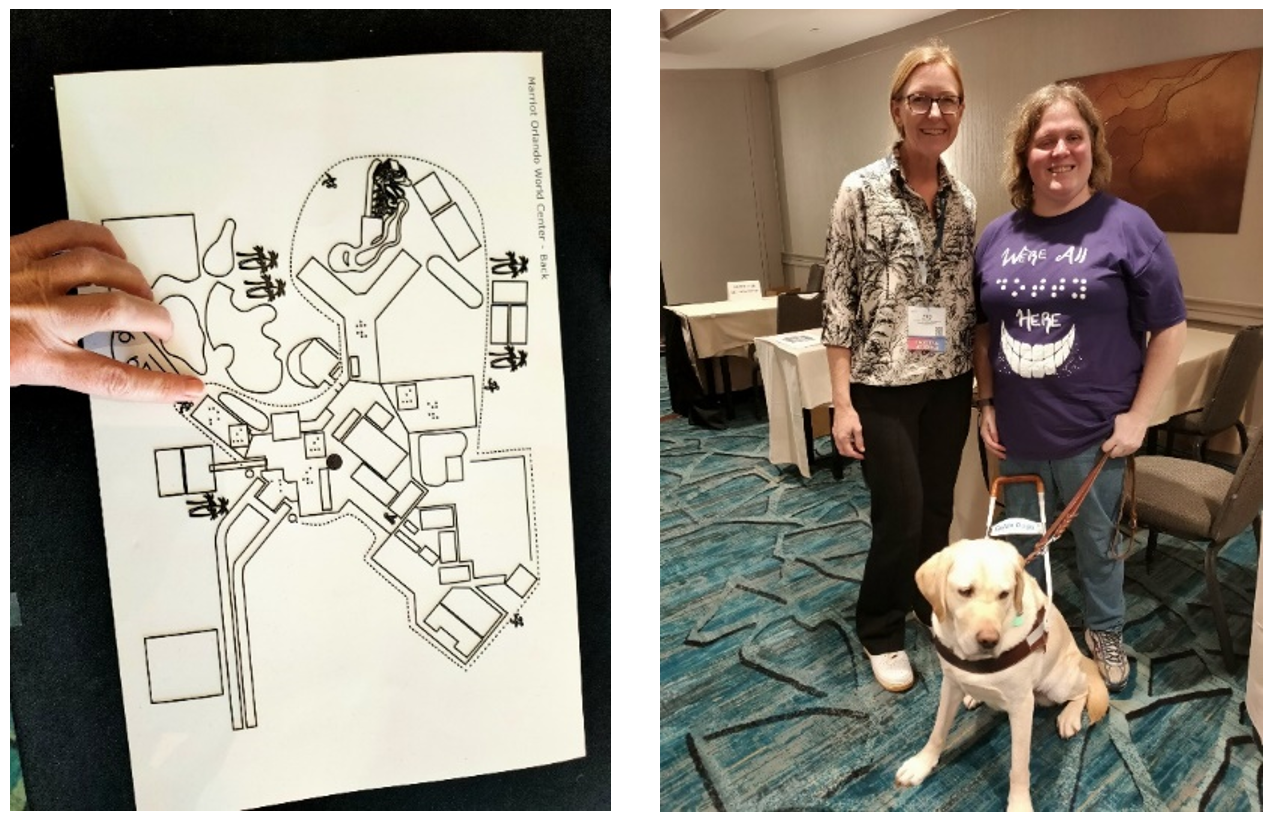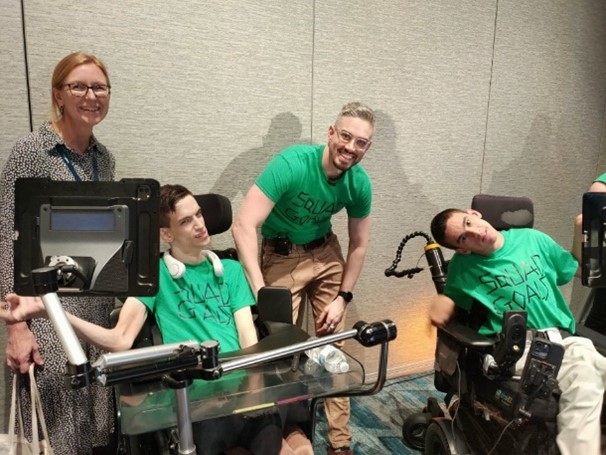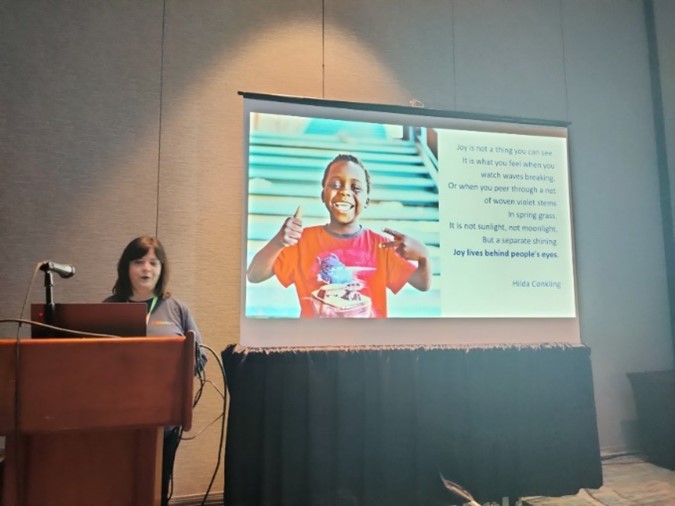The AT Scholarship Programme: Fostering Connections within the AT Community
The AT Scholarship Programme, established by Martin Littler in 2020, facilitates the attendance of professionals from the United Kingdom at the annual ATIA Conference in Orlando. This initiative fosters valuable connections within the assistive technology community by enabling participants to engage in meaningful dialogue and exchange knowledge with peers from diverse backgrounds. The programme is now overseen by Ace Centre, ensuring its continued success and positive impact. I highly recommend this exceptional opportunity to anyone with a special interest in Assistive Technology (AT) or Augmentative and Alternative Communication (AAC). Personally, participation in the programme has proven to be a transformative experience, significantly broadening my perspective and sparking a profound desire to connect with a wider network of technology users, providers and other professionals in the field. I am deeply grateful for this invaluable opportunity and the positive impact it has already had on my professional outlook and aspirations.

The Fundamental Need for Connection
The fundamental human need for connection permeates every aspect of our existence. This intrinsic desire goes beyond mere physical survival – once our basic physiological needs are met, we yearn to forge meaningful bonds with the world around us. This includes establishing connections with places, spaces, objects, and most importantly, other humans. For some people, this can be more of a challenge than others, and yet there is still an over-riding drive to overcome life’s barriers and make those connections. As Abraham Maslow outlined in his Hierarchy of Needs (https://www.simplypsychology.org/maslow.html), secure attachment and a sense of belonging rank high on the ladder of human motivation. These connections fulfill our emotional needs for love, acceptance, and belonging, ultimately contributing to our self-esteem and sense of worth. Only then can we truly strive towards self-actualisation, the peak of Maslow’s hierarchy, where we reach our full potential and achieve ultimate fulfillment. Within my field of work at CENMAC (a London-based outreach and advisory service providing AT and AAC) I endeavour to support children and young people to make those connections with the world through encouraging greater independence with learning and communication.
Lift-off
My attendance at the 2024 ATIA Conference provided me with an unparalleled experience of human connection. This journey began at Gatwick airport, where a chance encounter with a fellow solo traveler sparked a memorable conversation. This remarkable woman, a former BBC Horizon editor and head of the BBC Science unit, was embarking on an adventurous expedition to a remote island off Papua New Guinea. As we shared details about our lives, families, and careers, a deeper connection developed. When she talked about her grandson who has Down’s Syndrome, I was able to offer suggestions of resources which might support his learning style. This initial interaction, exemplifying Maslow’s principle of belonging and esteem fulfillment, perfectly encapsulates the essence of the ATIA conference. The following days spent in Orlando were characterised by a multitude of similar connections, cultivating a sense of community unlike any other I have encountered.
Meeting a Fellow First-Timer
During the conference I met a fellow first-time attendee who had travelled from South Carolina. Our initial connection centred around the fact that we both have cousins who live in Norwich, and we quickly became fast friends, with a mutual appreciation for the humorous braille t-shirts available from the Aloha Braille company. We chatted about our experiences of the conference and Nancy, who works at a school for the Deaf and Blind and is registered blind herself, described the conference venue as initially overwhelming and explained that she had no real concept of where anything was. Navigating the vast hotel and understanding the layout presented challenges, despite the availability of tactile maps and sighted guides. While finding these accessibility aids helpful, Nancy still found the sheer size and layout mentally taxing.

Nancy was super excited that she could download sessions from the ATIA mobile app and have the slides for each session readily available in advance to her. This was important for Nancy, as she hadn’t learnt braille until the age of fourteen, and she still finds it a challenge to take notes and keep up with faster paced sessions. Without the option to download session notes and slides in advance, Nancy felt that she would have experienced much greater physical and visual fatigue. The only downside to the mobile app, which I also experienced, is that there is so much available, that it can be hard to narrow down your chosen sessions, for example, if you select one of the strands, then you may find that you miss information on sessions which do not fall within that strand.
Nancy felt that the most exciting new piece of technology that she had discovered was the Monarch tactile device from Humanware and American Printing House (APH). She feels that this will be a real game-changer and she is looking forward to using it with the young people that she works with. I agree that tactile graphics and having information at the same time as sighted peers in the classroom is an essential part of learning, and supports students in making the connections needed to have a full understanding of new concepts. One of the sessions that I attended was from the maker of a device called the Tactonom reader, which, in a similar vein to the Monarch, assists students in exploring tactile diagrams with their fingers. The Tactonom relies on raised dot print-outs which are then attached to the reader plate. One of the advantages of the Tactonom is that through the in-built camera, the technology can see where a student is placing their fingers, and then deliver audio information at the same time about what the student is feeling, for an enhanced multi-sensory learning experience.
Finally, I asked Nancy if she had any tips for future first-timers to ATIA and about her favourite parts of the conference. Her main tips were around being aware that this is not a small conference, there were around 3,000 attendees this year, plus all the presenters, exhibitors and those joining online, making it a truly mammoth event. Nancy felt that she hadn’t quite known how to prepare sufficiently, in advance of the conference and that she hadn’t been too sure what to bring. I felt the same, and we decided between us that although the pre-conference orientation webinar had answered some of our questions, that it would be helpful to have a dedicated “Top Tips” page on the conference website for new attendees. Nancy found another challenge was keeping all her devices charged throughout the day, so would recommend that people bring power banks as it is not always easy to find charging points between seminar sessions. Nancy also felt that the hotel could be improved in terms of access, although this is a matter for the hotel to address, not ATIA – she wished there could be AIRA access at the hotel (https://aira.io/), braille signage, contrasting edging on stairs, and improved colour contrast on hotel maps.
Nancy’s final observation resonated deeply, linking back to the theme of this report, and capturing the heart of the conference experience for many attendees: “My favourite part has been connecting with folks from all over – folks you would not have expected to see here.” This sentiment perfectly encapsulates the profound impact of building meaningful connections that transcend geographic boundaries and professional domains.
As part of my conference experience, I also wanted to step outside of my own domain a little and experience sessions and presentations with technologies that I am not as familiar with. Although CENMAC provides a plethora of assistive technologies to support a wide range of disabilities, my specialism lies within supporting those with vision impairments, and I do not have a large number of children and young people who use AAC on my own caseload. To support my understanding in this area, I selected a number of sessions within this strand, each of which looked to delve into more than the fundamentals of using AAC to make choices and request basic needs.
Squad goals
The main premise behind one of my chosen seminars was the connection that had been forged by attendees of last year’s conference. Bradley Heaven and Daniel O’Connor (co-founders of All Access Life) were co-presenting a session titled “Squad Goals” with Hank Poore (an assistive technology user and advocate, working for United Ability) and Elizabeth Stewart (an assistive technology specialist at United Ability) on the difficulties that can be faced by AAC users when developing meaningful friendships. Hank and Brad had hit it off at ATIA 2023 after discovering their similarities and that they both use the same AAC software. Their presentation this year highlighted the need for everyone to experience close friendships and to feel a sense of belonging in a ‘squad’, as well as discussing the challenges experienced by AAC users when trying to develop and maintain friendships.


Joy of communication
In another of my selected sessions, Bethany Diener (Clinical Assistive Communication Manager at Tobii Dynavox) spoke about the criteria used by professionals for deciding whether AAC is being used successfully, and how this can often strip away the joy that communication can bring. Bethany guided attendees in exploring, identifying and inspiring joyful communication. This served as a reminder that humans seek joy in their connections, which can be seen from very early interactions onwards, and that it is important to maintain this joyfulness when supporting the implementation of AAC.

Computer control in the mouth
I could not end my report without talking about one of the standout pieces of new technology that I saw in action at the event. The MouthPad from Augmental has the power to be a game-changing device for so many people who require alternative access methods for computer control, communication and environmental control. The MouthPad is a small, inconspicuous device which sits on the roof of the mouth, held in place by a moulded retainer, and operated by the tongue. It can be worn whilst talking and also used in conjunction with other devices. I was very impressed by the elegant simplicity of the design and the way in which it can be operated so easily by the tongue. Since returning to the UK, I have been in contact with someone based in New York, who has been part of Augmental’s early access program, and it has been fascinating to hear about her use of the device.
Key takeaways and conclusion
Experiencing ATIA as one of this year’s UK AT Scholars was a great privilege and honour, and I can’t express my thanks enough to Martin Littler for funding this, and Ace Centre for continuing the implementation of the programme. I would also like to thank the Inclusive TLC family for their warm welcome whilst in Orlando and for the evening celebration dinner. Thanks also to the UK contingent of suppliers and exhibitors, many of whom took the time to make contact before my visit to provide advice and offer guidance whilst at the conference. Also huge thanks to the ATIA team and the AT community in the US for their excellent event and hospitality, it was a real eye-opener, and I hope one day to return.

My key take-away from attending ATIA is that the AT community is like no other, and the sense of togetherness with common goals in mind was incredibly powerful. One more huge thank you goes to the other in-person scholar from this year’s cohort, Mary Lavender, who was a joy to spend time with.
What next?
Since returning to the UK, I have been in contact with a number of the companies that I met at ATIA, as well as with a number of AAC and AT users who have shared their stories with the CENMAC audience. I have also given feedback on my experiences and on the vast array of exciting technology that I saw to the CENMAC team, to Sensory Service Teams in London and to teachers and teaching assistants around London when visiting them to work with CENMAC students. I will also be sharing my highlights at CENMAC’s Communication Works event.

I have made contact with the keynote speaker from this year’s event, Karanveer Singh, an AAC user, who very kindly filmed a motivational video for some of the young people that CENMAC works with. I have also been speaking with another inspirational young woman, Esther Klang, who is also a keen tech user and has written about her experiences of using the MouthPad in a CENMAC blog.
I would highly recommend this experience to any other AT professionals who may be thinking of applying for next year’s scholarship – it really is a one-of-a-kind event!
For more information about the AT Scholar program and how to apply please visit acecentre.org.uk/at-scholar
Questions about the program or for Mary Long can be sent to [email protected].
